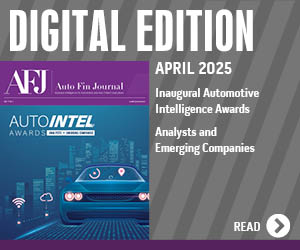COMMENTARY: A technology-driven approach puts the brakes on auto-lending fraud

As auto-lending fraud becomes an increasingly sophisticated and prevalent threat, auto lenders must act decisively to protect their businesses. By embracing advanced technology, including AI-driven analytics, real-time decisioning, and continuous monitoring, lenders can stay one step ahead of fraudsters, ensuring that both their operational efficiency and customer satisfaction remain strong.
The high-value transactions associated with car buying coupled with an increased shift toward digital loan applications, are giving fraudsters a significant attack surface area. As a result, auto lenders are now in a high-stakes environment, where the need for instant loan approvals and seamless customer experiences must be balanced with robust risk management and fraud prevention protocols.
The pressure for fast, efficient processing is mounting, driven by consumer demands for speed and the growing competition among lenders. Unfortunately, this has created gaps in the system that fraudsters are quick to exploit, risking not only financial stability and profitability but also the reputation of lenders in a highly competitive market.
Why auto lending is a prime target for fraudsters
To understand how to implement a strategy to address this growing risk, it’s important to first know why fraud is so prevalent in auto lending.
Auto loans involve large sums of money, making them an attractive target for criminals seeking high returns from successful scams. Additionally, fluctuations in vehicle prices, inflation, and interest rates can push both individuals and organized crime groups into fraud schemes, increasing the volume and complexity of fraud.
Today’s instant gratification and digital-first world also plays a role. Consumers expect instant loan approvals and frictionless experiences. However, the pressure to provide quick decisions often results in lenders prioritizing speed over thorough fraud mitigation, leaving opportunities for fraudsters. Plus, as more loan applications move online, digital fraud schemes, such as identity theft and synthetic identities, have become more sophisticated and harder to detect.
These factors have created a perfect storm, making the auto lending sector increasingly vulnerable to fraud.
The many faces of auto lending fraud
Fraud manifests in numerous ways, each presenting unique challenges for lenders. To stay ahead, understanding the different types of fraud and their implications is crucial.
For example, application/first-party fraud occurs when individuals submit false or fabricated identities and employment/income details to qualify for loans they would not otherwise receive. It is the most common form of fraud, making up nearly 80% of all cases.
Synthetic identity fraud involves creating new identities by combining real and fabricated information (e.g., using a valid Social Security number with fake personal details). These identities often have clean credit histories, making it difficult to spot and enabling fraudsters to secure large loans before disappearing.
With loan stacking, fraudsters may apply for multiple loans from different lenders without the lenders’ knowledge, often walking away with several financed vehicles before the credit bureaus update their records.
There are also schemes designed to deceive lenders and buyers by misrepresenting the value and history of vehicles, including title washing which involves altering a car’s title to hide accident history or salvage status, and re-vinning which is the practice of replacing a vehicle’s original VIN with a counterfeit one.
Fraud can even come from insider the dealership. In some cases, dishonest dealers work together with fraudsters to falsify vehicle prices or loan documents, resulting in inflated loan amounts and higher risks for lenders when the loan defaults.
Implementing a technology strategy to combat auto lending fraud
To stay ahead of fraud while ensuring operational efficiency and customer satisfaction, a multi-faceted approach is essential. Here are five key strategies that can help auto lenders mitigate fraud risks:
- Advanced data analytics: Utilizing data-driven tools is critical for early fraud detection. These tools can spot patterns and discrepancies that may not be visible through manual reviews, such as irregular income reports or patterns associated with synthetic IDs.
- Identity verification tools: Integrating identity verification (IDV) technologies — such as biometrics and document verification — can authenticate applicants’ identities and ensure that the person applying for the loan is who they say they are. This helps prevent identity theft and false applications.
- Fraud detection software: Real-time decisioning and machine learning models allow lenders to instantly detect suspicious activity. By automating repetitive tasks, fraud detection software enhances efficiency while ensuring compliance with regulations.
- Cross-industry collaboration: Sharing fraud intelligence with other financial institutions can help lenders stay updated on emerging fraud tactics and ensure a more unified, proactive defense against fraud.
- Continuous monitoring: Fraud prevention doesn’t end after the loan application is processed. Monitoring loan portfolios and borrower behavior throughout the loan lifecycle enables lenders to spot potential fraud before it escalates.
Future-proofing fraud strategies
Adopting scalable, cloud-based fraud detection solutions is critical to maintaining long-term fraud resilience. Cloud-based platforms offer flexibility, real-time updates, and AI-powered analytics — all of which enable lenders to continuously improve their fraud detection systems. Given AI abilities to process vast amounts of data quickly, fraud detection can become faster, more accurate, and more adaptive to emerging threats.
The future of auto lending depends on proactively addressing fraud risk — and with the right tools and strategies in place, lenders can protect their bottom line and reputation while providing a secure, seamless experience for customers.
Brendan Deakin is general manager, U.S. market, with Provenir, a global leader in AI risk decisioning software. In this role, Brendan leads Provenir’s North America sales, operations and customer success teams. Brendan has more than 20 years of sales leadership experience within the consumer finance and credit services industries. Prior to joining Provenir in 2019, Brendan spent five years as an investor and executive with RevolutionCredit, a behavioral science-based fintech/credit scoring solution targeted for thin-file and new to credit consumers. Brendan also served as vice president of North American Sales at Argus Information and Analytic Services (now part of TransUnion). Prior to Argus, Brendan held a variety of senior sales management roles at Experian Credit Services and Decision Analytics, including Strategic Sales and Experian Health during his more than years at the firm.


